Seat Alhambra 2011 Owner's Manual
Manufacturer: SEAT, Model Year: 2011, Model line: Alhambra, Model: Seat Alhambra 2011Pages: 385, PDF Size: 7.92 MB
Page 201 of 385
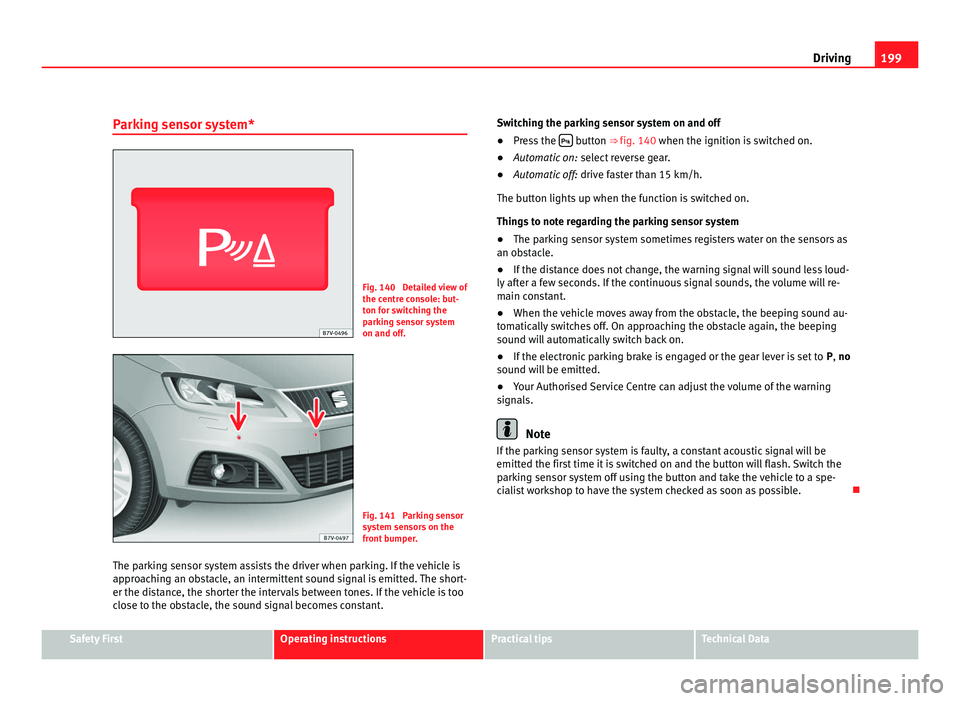
199
Driving
Parking sensor system* Fig. 140 Detailed view of
the centr
e c
onsole: but-
ton for switching the
parking sensor system
on and off. Fig. 141 Parking sensor
sys
t
em sensors on the
front bumper.
The parking sensor system assists the driver when parking. If the vehicle is
appro
aching an obstacle, an intermittent sound signal is emitted. The short-
er the distance, the shorter the intervals between tones. If the vehicle is too
close to the obstacle, the sound signal becomes constant. Switching the parking sensor system on and off
●
Press the button ⇒
fig. 140 when the ignition i
s switched on.
● Automatic on: select r
everse gear.
● Automatic off: drive fa
ster than 15 km/h.
The button lights up when the function is switched on.
Things to note regarding the parking sensor system
● The parking sensor system sometimes registers water on the sensors as
an obs
tacle.
● If the distance does not change, the warning signal will sound less loud-
ly aft
er a few seconds. If the continuous signal sounds, the volume will re-
main constant.
● When the vehicle moves away from the obstacle, the beeping sound au-
tomatic
ally switches off. On approaching the obstacle again, the beeping
sound will automatically switch back on.
● If the electronic parking brake is engaged or the gear lever is set to P, no
sound wi
ll be emitted.
● Your Authorised Service Centre can adjust the volume of the warning
signal
s. Note
If the parking sensor system is faulty, a constant acoustic signal will be
emitted the fir s
t time it is switched on and the button will flash. Switch the
parking sensor system off using the button and take the vehicle to a spe-
cialist workshop to have the system checked as soon as possible. Safety First Operating instructions Practical tips Technical Data
Page 202 of 385
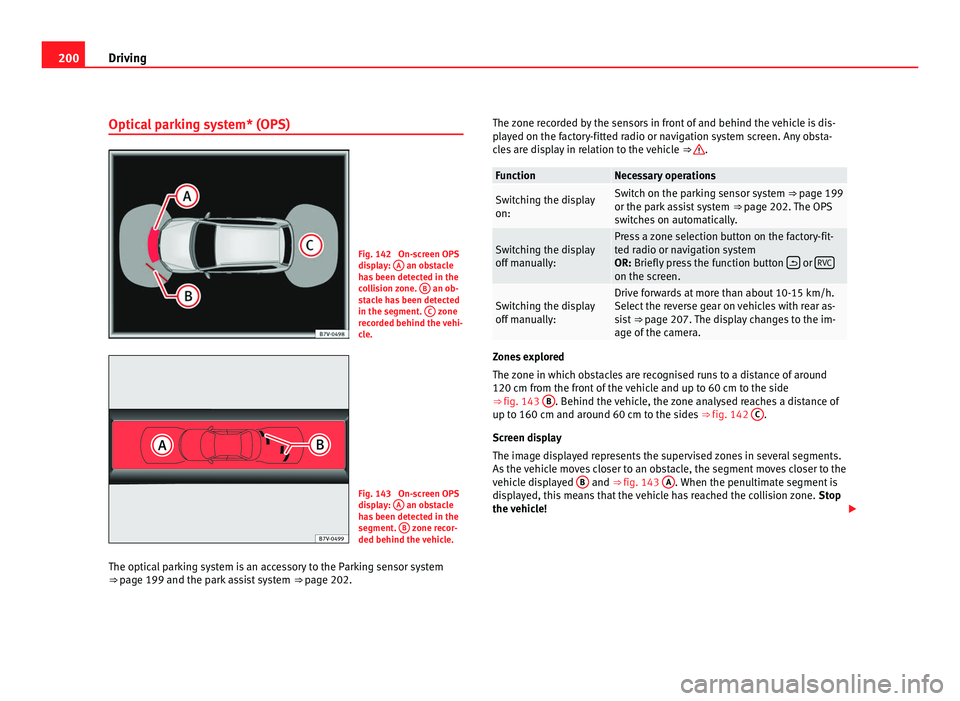
200
Driving
Optical parking system* (OPS) Fig. 142 On-screen OPS
dis
p
lay: A an obstacle
ha s
been detected in the
collision zone. B an ob-
st ac
le has been detected
in the segment. C zone
rec or
ded behind the vehi-
cle. Fig. 143 On-screen OPS
dis
p
lay: A an obstacle
ha s
been detected in the
segment. B zone recor-
ded behind the v ehic
le.
The optical parking system is an accessory to the Parking sensor system
⇒ page 199 and the p
ark assist system ⇒ page 202. The zone recorded by the sensors in front of and behind the vehicle is dis-
pla
yed on the factory-fitted radio or navigation system screen. Any obsta-
cles are display in relation to the vehicle ⇒ .
Function Necessary operations
Switching the display
on: Switch on the parking sensor system ⇒ pag
e 199
or the p
ark assist system ⇒ page 202. The OPS
switches on automatically. Switching the display
off m
anual
ly: Press a zone selection button on the factory-fit-
ted r
a
dio or navigation system
OR: Briefly press the function button or
RVC on the screen.
Switching the display
off m
anual
ly: Drive forwards at more than about 10-15 km/h.
Select
the r
everse gear on vehicles with rear as-
sist ⇒ page 207. The display changes to the im-
age of the camera. Zones explored
The z
one in whic
h obstacles are recognised runs to a distance of around
120 cm from the front of the vehicle and up to 60 cm to the side
⇒ fig. 143 B . Behind the vehicle, the zone analysed reaches a distance of
up to 160 c m and ar
ound 60 cm to the sides ⇒ fig. 142 C .
Scr een di
splay
The image displayed represents the supervised zones in several segments.
As the vehicle moves closer to an obstacle, the segment moves closer to the
vehicle displayed B and ⇒ fig. 143
A . When the penultimate segment is
dis p
layed, this means that the vehicle has reached the collision zone. Stop
the vehicle!
Page 203 of 385
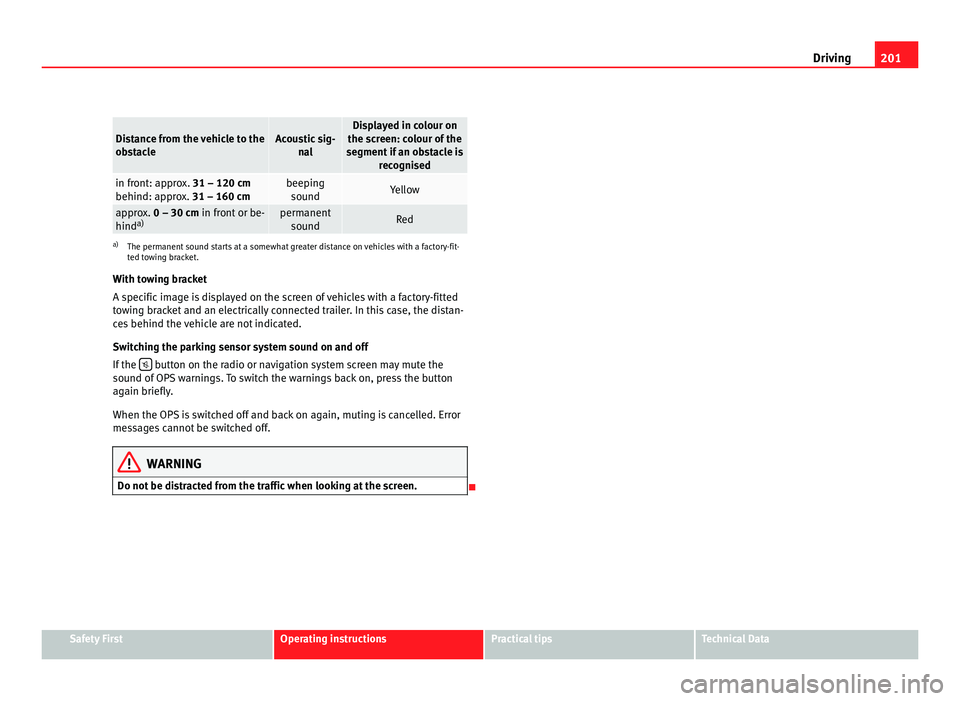
201
Driving Distance from the vehicle to the
ob
s
tacle Acoustic sig-
nal Displayed in colour on
the sc r
een: colour of the
segment if an obstacle is recognised in front: approx. 31 – 120 cm
behind: ap
pr
ox. 31 – 160 cm beeping
sound Yellow
approx. 0 – 30 cm
in fr
ont or be-
hind a) permanent
sound Red
a)
The permanent sound starts at a somewhat greater distance on vehicles with a factory-fit-
ted t o
wing bracket.
With towing bracket
A specific image is displayed on the screen of vehicles with a factory-fitted
towing bracket and an electrically connected trailer. In this case, the distan-
ces behind the vehicle are not indicated.
Switching the parking sensor system sound on and off
If the button on the radio or navigation system screen may mute the
sound of OP
S warnings. To switch the warnings back on, press the button
again briefly.
When the OPS is switched off and back on again, muting is cancelled. Error
messages cannot be switched off. WARNING
Do not be distracted from the traffic when looking at the screen.
Safety First Operating instructions Practical tips Technical Data
Page 204 of 385
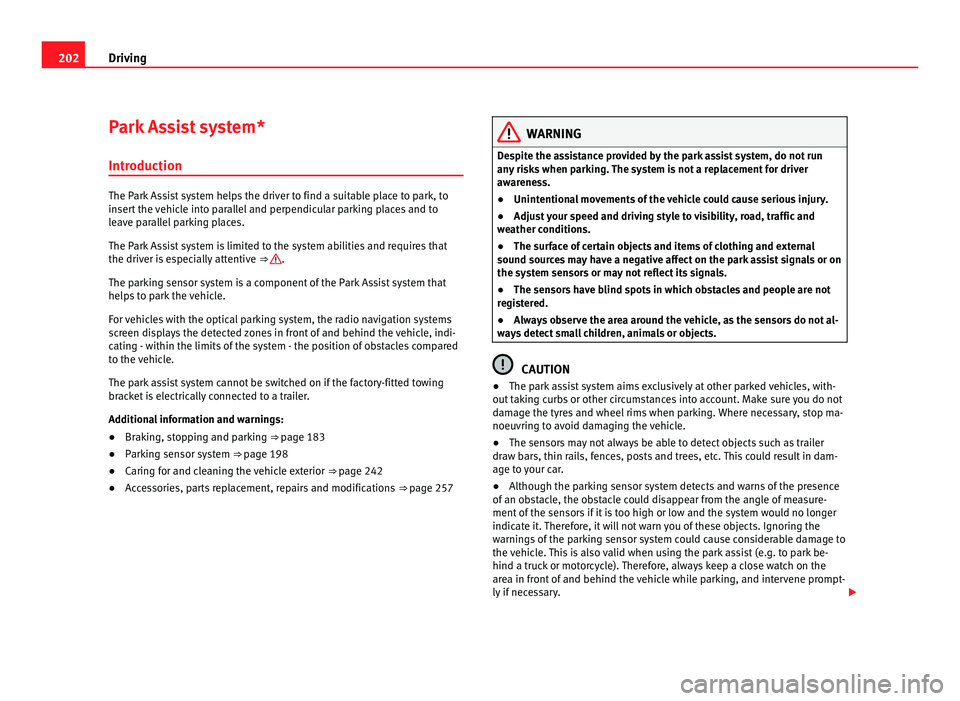
202
Driving
Park Assist system*
Introduction The Park Assist system helps the driver to find a suitable place to park, to
inser
t
the vehicle into parallel and perpendicular parking places and to
leave parallel parking places.
The Park Assist system is limited to the system abilities and requires that
the driver is especially attentive ⇒ .
The park in
g sensor system is a component of the Park Assist system that
helps to park the vehicle.
For vehicles with the optical parking system, the radio navigation systems
screen displays the detected zones in front of and behind the vehicle, indi-
cating - within the limits of the system - the position of obstacles compared
to the vehicle.
The park assist system cannot be switched on if the factory-fitted towing
bracket is electrically connected to a trailer.
Additional information and warnings:
● Braking, stopping and parking ⇒ page 183
● P
arking sensor system ⇒ page 198
● C
aring for and cleaning the vehicle exterior ⇒ page 242
● A
ccessories, parts replacement, repairs and modifications ⇒ page 257 WARNING
Despite the assistance provided by the park assist system, do not run
any ri
sks when parking. The system is not a replacement for driver
awareness.
● Unintentional movements of the vehicle could cause serious injury.
● Adjust your speed and driving style to visibility, road, traffic and
weather c
onditions.
● The surface of certain objects and items of clothing and external
sound sourc
es may have a negative affect on the park assist signals or on
the system sensors or may not reflect its signals.
● The sensors have blind spots in which obstacles and people are not
regi
stered.
● Always observe the area around the vehicle, as the sensors do not al-
way
s detect small children, animals or objects. CAUTION
● The park assist system aims exclusively at other parked vehicles, with-
out t
aking curbs or other circumstances into account. Make sure you do not
damage the tyres and wheel rims when parking. Where necessary, stop ma-
noeuvring to avoid damaging the vehicle.
● The sensors may not always be able to detect objects such as trailer
draw b
ars, thin rails, fences, posts and trees, etc. This could result in dam-
age to your car.
● Although the parking sensor system detects and warns of the presence
of an ob
stacle, the obstacle could disappear from the angle of measure-
ment of the sensors if it is too high or low and the system would no longer
indicate it. Therefore, it will not warn you of these objects. Ignoring the
warnings of the parking sensor system could cause considerable damage to
the vehicle. This is also valid when using the park assist (e.g. to park be-
hind a truck or motorcycle). Therefore, always keep a close watch on the
area in front of and behind the vehicle while parking, and intervene prompt-
ly if necessary.
Page 205 of 385
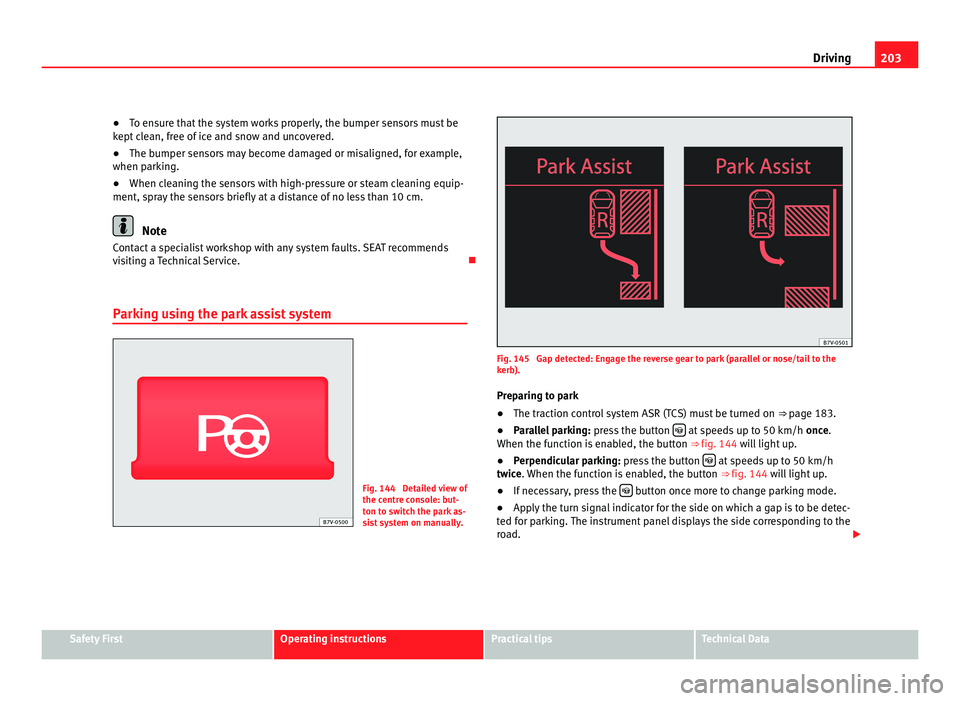
203
Driving
● To ensure that the system works properly, the bumper sensors must be
k ept
clean, free of ice and snow and uncovered.
● The bumper sensors may become damaged or misaligned, for example,
when parkin
g.
● When cleaning the sensors with high-pressure or steam cleaning equip-
ment, spra
y the sensors briefly at a distance of no less than 10 cm. Note
Contact a specialist workshop with any system faults. SEAT recommends
vi s
iting a Technical Service.
Parking using the park assist system Fig. 144 Detailed view of
the centr
e c
onsole: but-
ton to switch the park as-
sist system on manually. Fig. 145 Gap detected: Engage the reverse gear to park (parallel or nose/tail to the
kerb).
Pr ep
aring to park
● The traction control system ASR (TCS) must be turned on ⇒ page 183.
● P
arallel parking: pres
s the button at speeds up to 50 km/h
once.
When the f
unction is enabled, the button ⇒ fig. 144 will light up.
● Perpendicular parking: pres
s the button at speeds up to 50 km/h
twic e
. When the function is enabled, the button ⇒ fig. 144 will light up.
● If necessary, press the button once more to change parking mode.
● Apply the turn signal indicator for the side on which a gap is to be detec-
ted f or p
arking. The instrument panel displays the side corresponding to the
road. Safety First Operating instructions Practical tips Technical Data
Page 206 of 385
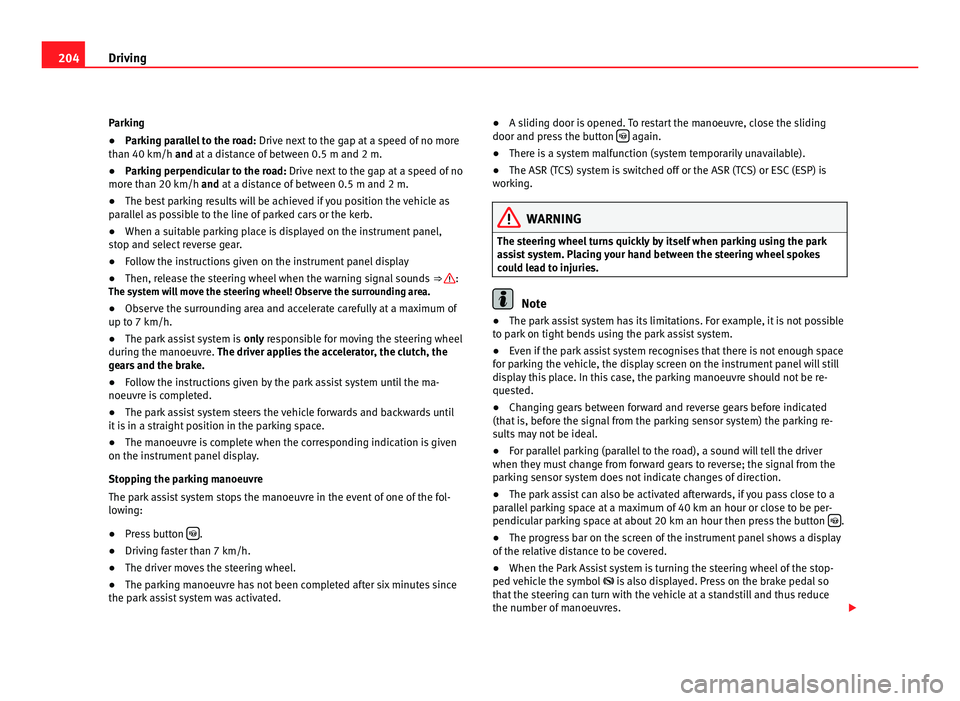
204
Driving
Parking
● Parking parallel to the road: Drive next to the gap at a speed of no more
than 40 km/h and at a distance of between 0.5 m and 2 m.
● Parking perpendicular to the road: Drive next
to the gap at a speed of no
more than 20 km/h and at a distance of between 0.5 m and 2 m.
● The best parking results will be achieved if you position the vehicle as
paral
lel as possible to the line of parked cars or the kerb.
● When a suitable parking place is displayed on the instrument panel,
stop and sel
ect reverse gear.
● Follow the instructions given on the instrument panel display
● Then, release the steering wheel when the warning signal sounds ⇒ :
The sys t
em will move the steering wheel! Observe the surrounding area.
● Observe the surrounding area and accelerate carefully at a maximum of
up to 7 km/h.
● The park
assist system is only r
esponsible for moving the steering wheel
during the manoeuvre. The driver applies the accelerator, the clutch, the
gears and the brake.
● Follow the instructions given by the park assist system until the ma-
noeuvre i
s completed.
● The park assist system steers the vehicle forwards and backwards until
it is
in a straight position in the parking space.
● The manoeuvre is complete when the corresponding indication is given
on the instrument
panel display.
Stopping the parking manoeuvre
The park assist system stops the manoeuvre in the event of one of the fol-
lowing:
● Press button .
● Driving faster than 7 km/h.
● The driver moves the steering wheel.
● The parking manoeuvre has not been completed after six minutes since
the park a
ssist system was activated. ●
A sliding door is opened. To restart the manoeuvre, close the sliding
door and pre
ss the button again.
● There is a system malfunction (system temporarily unavailable).
● The ASR (TCS) system is switched off or the ASR (TCS) or ESC (ESP) is
work in
g. WARNING
The steering wheel turns quickly by itself when parking using the park
as s
ist system. Placing your hand between the steering wheel spokes
could lead to injuries. Note
● The park assist system has its limitations. For example, it is not possible
t o p
ark on tight bends using the park assist system.
● Even if the park assist system recognises that there is not enough space
for park
ing the vehicle, the display screen on the instrument panel will still
display this place. In this case, the parking manoeuvre should not be re-
quested.
● Changing gears between forward and reverse gears before indicated
(that i
s, before the signal from the parking sensor system) the parking re-
sults may not be ideal.
● For parallel parking (parallel to the road), a sound will tell the driver
when they mus
t change from forward gears to reverse; the signal from the
parking sensor system does not indicate changes of direction.
● The park assist can also be activated afterwards, if you pass close to a
paral
lel parking space at a maximum of 40 km an hour or close to be per-
pendicular parking space at about 20 km an hour then press the button .
● The progress bar on the screen of the instrument panel shows a display
of the r el
ative distance to be covered.
● When the Park Assist system is turning the steering wheel of the stop-
ped vehic
le the symbol is also displayed. Press on the brake pedal so
that the steering can turn with the vehicle at a standstill and thus reduce
the number of manoeuvres.
Page 207 of 385
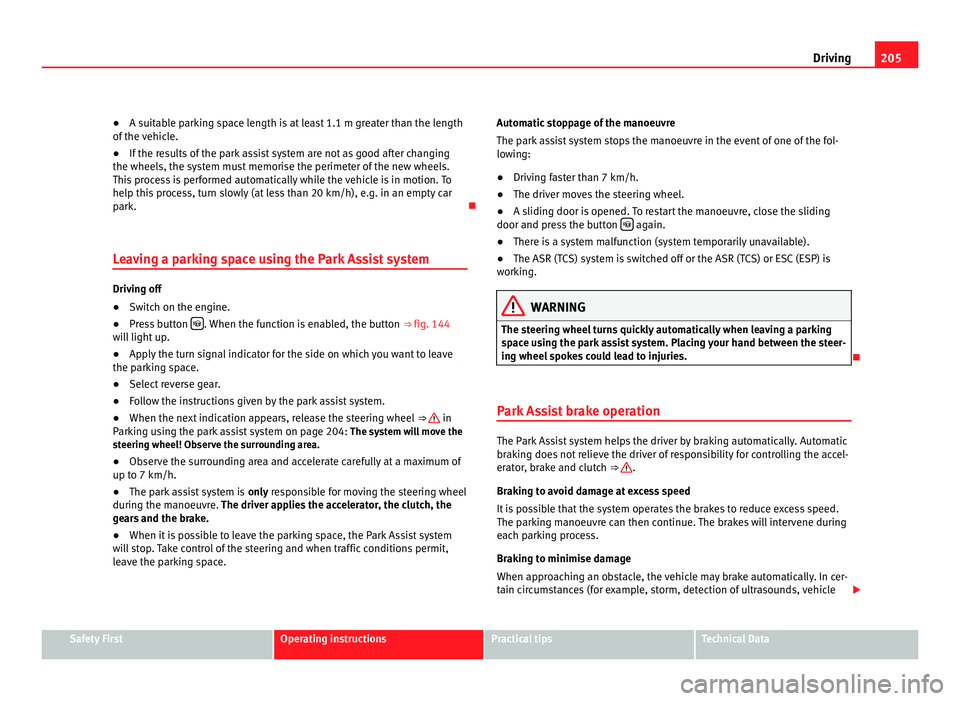
205
Driving
● A suitable parking space length is at least 1.1 m greater than the length
of the
vehicle.
● If the results of the park assist system are not as good after changing
the wheels, the sys
tem must memorise the perimeter of the new wheels.
This process is performed automatically while the vehicle is in motion. To
help this process, turn slowly (at less than 20 km/h), e.g. in an empty car
park.
Leaving a parking space using the Park Assist system Driving off
●
Switch on the engine.
● Press button . When the function is enabled, the button
⇒ fig. 144
wi l
l light up.
● Apply the turn signal indicator for the side on which you want to leave
the parkin
g space.
● Select reverse gear.
● Follow the instructions given by the park assist system.
● When the next indication appears, release the steering wheel ⇒ in
Park in
g using the park assist system on page 204: The system will move the
steering wheel! Observe the surrounding area.
● Observe the surrounding area and accelerate carefully at a maximum of
up to 7 km/h.
● The park
assist system is only r
esponsible for moving the steering wheel
during the manoeuvre. The driver applies the accelerator, the clutch, the
gears and the brake.
● When it is possible to leave the parking space, the Park Assist system
wil
l stop. Take control of the steering and when traffic conditions permit,
leave the parking space. Automatic stoppage of the manoeuvre
The park a
ssist system stops the manoeuvre in the event of one of the fol-
lowing:
● Driving faster than 7 km/h.
● The driver moves the steering wheel.
● A sliding door is opened. To restart the manoeuvre, close the sliding
door and pres
s the button again.
● There is a system malfunction (system temporarily unavailable).
● The ASR (TCS) system is switched off or the ASR (TCS) or ESC (ESP) is
work in
g. WARNING
The steering wheel turns quickly automatically when leaving a parking
sp ac
e using the park assist system. Placing your hand between the steer-
ing wheel spokes could lead to injuries.
Park Assist brake operation The Park Assist system helps the driver by braking automatically. Automatic
brak
in
g does not relieve the driver of responsibility for controlling the accel-
erator, brake and clutch ⇒ .
Brak in
g to avoid damage at excess speed
It is possible that the system operates the brakes to reduce excess speed.
The parking manoeuvre can then continue. The brakes will intervene during
each parking process.
Braking to minimise damage
When approaching an obstacle, the vehicle may brake automatically. In cer-
tain circumstances (for example, storm, detection of ultrasounds, vehicle Safety First Operating instructions Practical tips Technical Data
Page 208 of 385
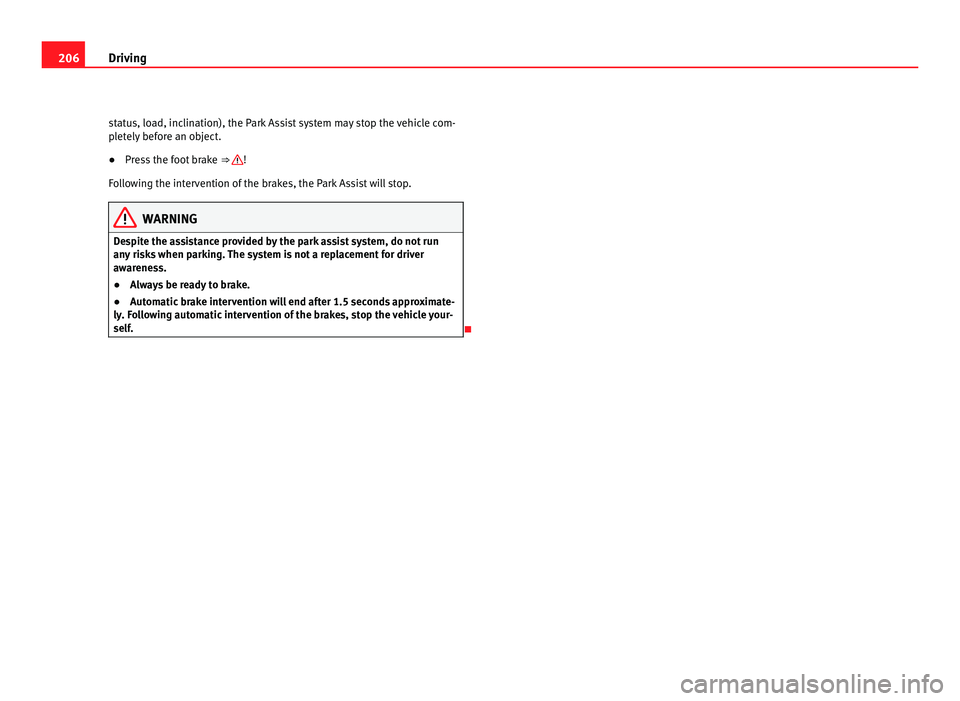
206
Driving
status, load, inclination), the Park Assist system may stop the vehicle com-
pl et
ely before an object.
● Press the foot brake ⇒ !
Fo l
lowing the intervention of the brakes, the Park Assist will stop. WARNING
Despite the assistance provided by the park assist system, do not run
any ri
sks when parking. The system is not a replacement for driver
awareness.
● Always be ready to brake.
● Automatic brake intervention will end after 1.5 seconds approximate-
ly. Fo
llowing automatic intervention of the brakes, stop the vehicle your-
self.
Page 209 of 385
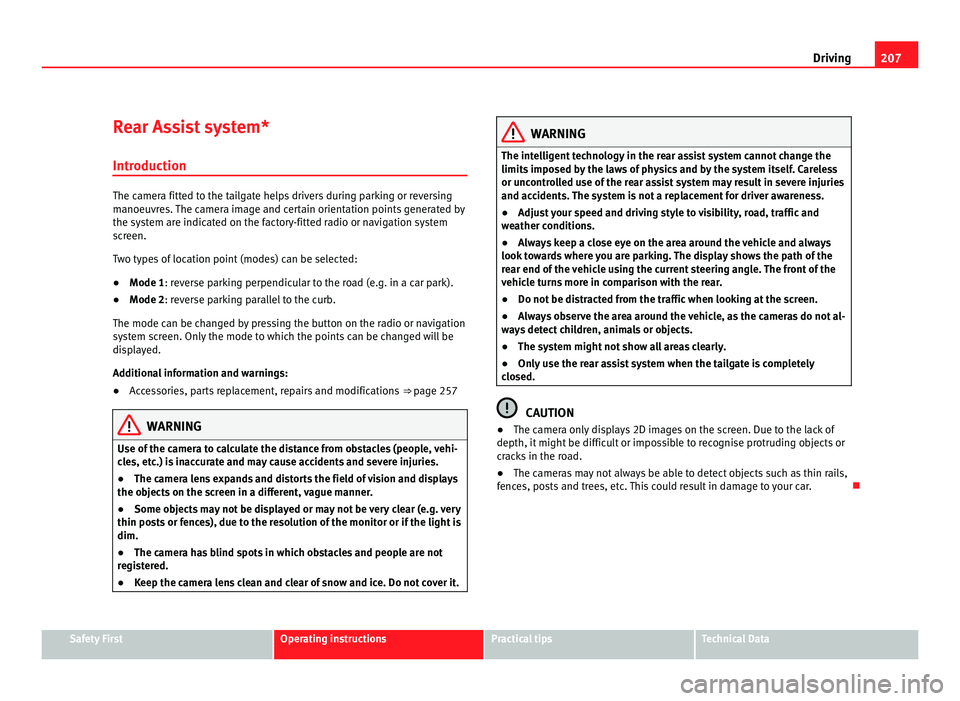
207
Driving
Rear Assist system*
Introduction The camera fitted to the tailgate helps drivers during parking or reversing
manoeu
vr
es. The camera image and certain orientation points generated by
the system are indicated on the factory-fitted radio or navigation system
screen.
Two types of location point (modes) can be selected:
● Mode 1: reverse parking perpendicular to the road (e.g. in a car park).
● Mode 2: r
everse parking parallel to the curb.
The mode can be c
hanged by pressing the button on the radio or navigation
system screen. Only the mode to which the points can be changed will be
displayed.
Additional information and warnings:
● Accessories, parts replacement, repairs and modifications ⇒ page 257WARNING
Use of the camera to calculate the distance from obstacles (people, vehi-
cl e
s, etc.) is inaccurate and may cause accidents and severe injuries.
● The camera lens expands and distorts the field of vision and displays
the obj
ects on the screen in a different, vague manner.
● Some objects may not be displayed or may not be very clear (e.g. very
thin post
s or fences), due to the resolution of the monitor or if the light is
dim.
● The camera has blind spots in which obstacles and people are not
regi
stered.
● Keep the camera lens clean and clear of snow and ice. Do not cover it. WARNING
The intelligent technology in the rear assist system cannot change the
limits impo
sed by the laws of physics and by the system itself. Careless
or uncontrolled use of the rear assist system may result in severe injuries
and accidents. The system is not a replacement for driver awareness.
● Adjust your speed and driving style to visibility, road, traffic and
weather c
onditions.
● Always keep a close eye on the area around the vehicle and always
look to
wards where you are parking. The display shows the path of the
rear end of the vehicle using the current steering angle. The front of the
vehicle turns more in comparison with the rear.
● Do not be distracted from the traffic when looking at the screen.
● Always observe the area around the vehicle, as the cameras do not al-
way
s detect children, animals or objects.
● The system might not show all areas clearly.
● Only use the rear assist system when the tailgate is completely
closed. CAUTION
● The camera only displays 2D images on the screen. Due to the lack of
depth, it might
be difficult or impossible to recognise protruding objects or
cracks in the road.
● The cameras may not always be able to detect objects such as thin rails,
fence
s, posts and trees, etc. This could result in damage to your car. Safety First Operating instructions Practical tips Technical Data
Page 210 of 385
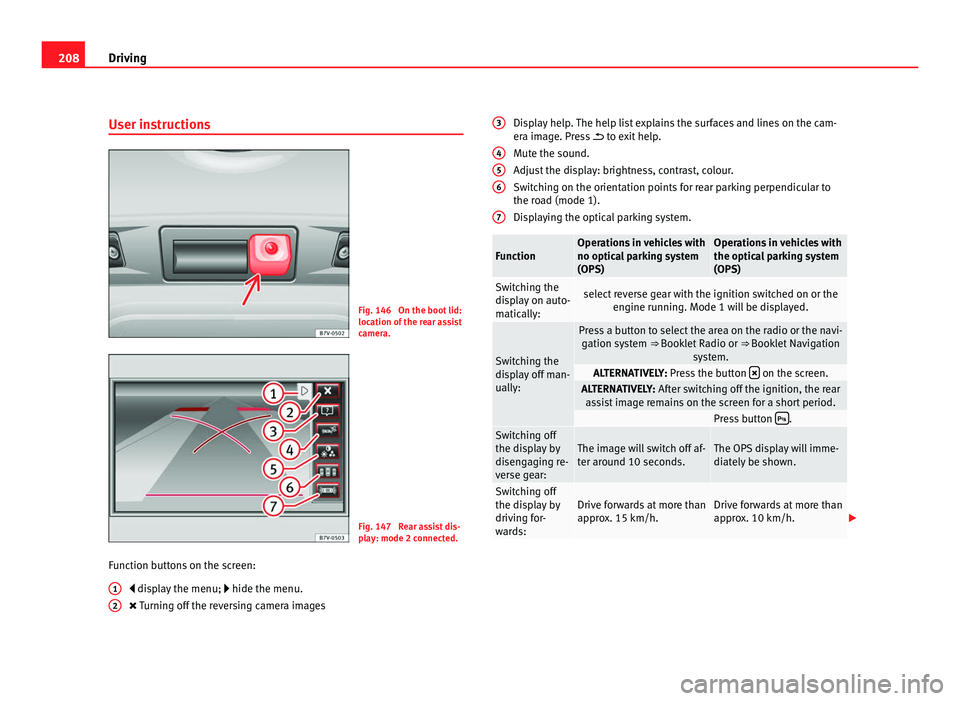
208
Driving
User instructions Fig. 146 On the boot lid:
location of
the r
ear assist
camera. Fig. 147 Rear assist dis-
pl
a
y: mode 2 connected.
Function buttons on the screen: disp
lay the menu; hide the menu.
Turning off the reversing camera images
1 2 Display help. The help list explains the surfaces and lines on the cam-
era im
ag
e. Press to exit help.
Mute the sound.
Adjust the display: brightness, contrast, colour.
Switching on the orientation points for rear parking perpendicular to
the road (mode 1).
Displaying the optical parking system. Function Operations in vehicles with
no optica
l
parking system
(OPS) Operations in vehicles with
the optica
l
parking system
(OPS) Switching the
dis
p
lay on auto-
matically: select reverse gear with the ignition switched on or the
engine ru nnin
g. Mode 1 will be displayed. Switching the
dis
p
lay off man-
ually: Press a button to select the area on the radio or the navi-
gation sy s
tem ⇒ Booklet Radio or ⇒ Booklet Navigation
system. ALTERNATIVELY: Pre
s
s the button on the screen.
ALTERNATIVELY: Aft
er sw
itching off the ignition, the rear
assist image remains on the screen for a short period. Press button
.
Switching off
the dis
p
lay by
disengaging re-
verse gear: The image will switch off af-
ter ar
ou
nd 10 seconds. The OPS display will imme-
diat
ely
be shown. Switching off
the dis
p
lay by
driving for-
wards: Drive forwards at more than
appr
o
x. 15 km/h. Drive forwards at more than
appr
o
x. 10 km/h. 3
4
5
6
7